Introduction
The major aspects to consider regarding special education are:
- Special education aims;
- Stakeholders involved;
- Programs and legislation.
The primary goal of special education is to ensure equal access of all children to high-quality education. All American children’s right to access quality education is safeguarded by certain regulations including the Individuals with Disabilities Education Act (IDEA) of 1975 and Section 504 of the Rehabilitation Act of 1973 (Pierson, Callan, & Pierson, 2017). Schools are required to provide special education to eligible children. However, parents also play an important role in the process as they may initiate their child’s participation in a special education program (Lipkin & Okamoto, 2015). Parents are also involved in the development of the most appropriate education plan for their children.
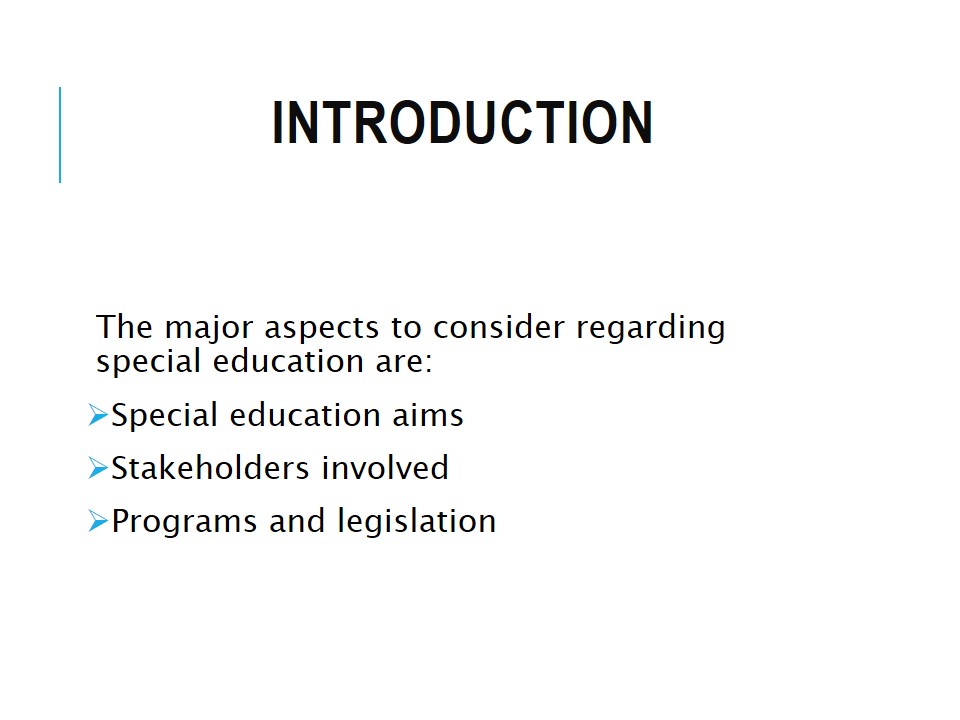
IDEA and Section 504
The Individuals with Disabilities Education Act (IDEA) of 1975 and Section 504 of the Rehabilitation Act of 1973 are some of the major laws addressing this goal (Pierson et al., 2017). Children with special needs may receive special education services that may include accommodation, transportation, certain resources in accordance with one of these laws. IDEA and Section 504 have certain differences as the latter is broader in scope and is less bound to strict requirements. Schools receive additional funding to ensure the implementation of IDEA, but no funding is provided for schools in terms of Section 504. Moreover, schools may lose public funding if they do not comply with Section 504.
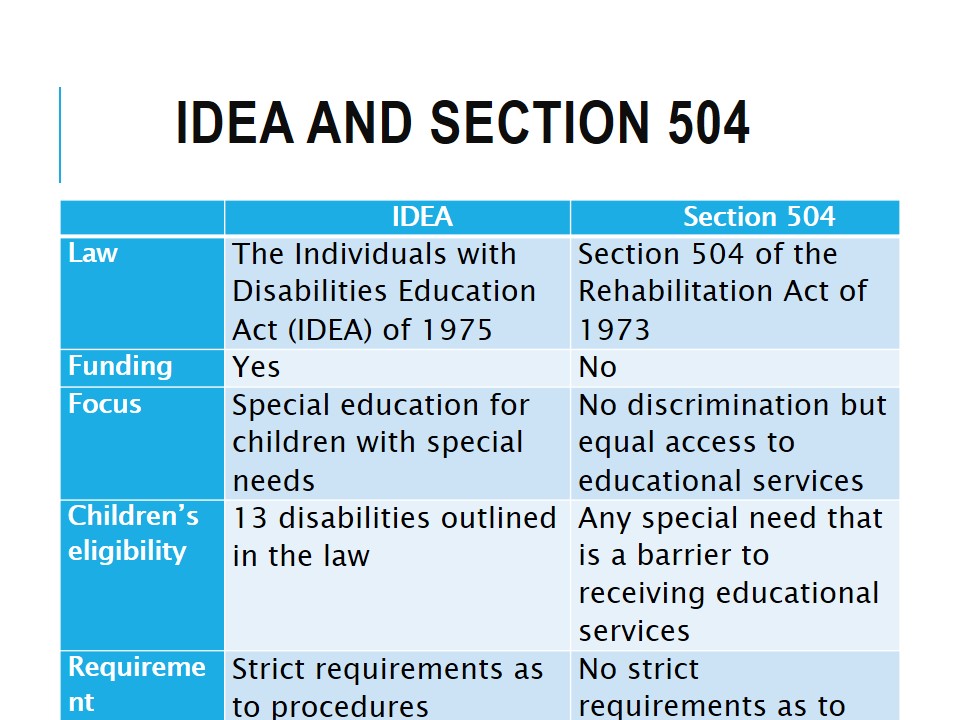
Special education identification
- School Referral / Family Referral;
- Child Find;
- Special Education Evaluation.
As mentioned above, according to IDEA, all public schools must identify and evaluate children who may need special education services due to their disability (Olson, 2017). This process is referred to as Child Find, and it can be initiated by both schools (administration, faculty, other specialists) and family (parents, guardians, or caregivers). The parents of children between 3 and 5 years old can consider contacting the corresponding professionals if they feel their child has special needs. Parents only need to contact their local school district and they receive the information regarding the program and coordinators who will provide detailed information. If the school provides a referral, parents’ consent to implement their child’s evaluation should be obtained (Olson, 2017). When the family provides the referral, they also provide written consent to conduct the implementation of their child.
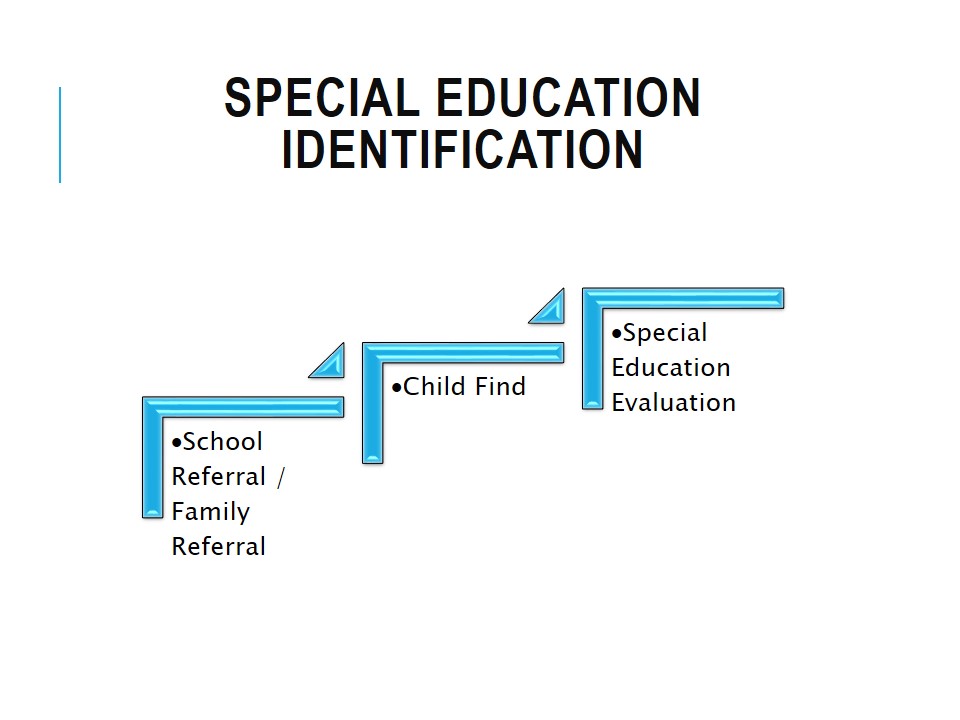
Special Education Evaluation
- Special Education Plans;
- Parents’ Consent;
- Evaluation;
- Decision.
The evaluation process starts after the provision of parents’ consent form (Lawless Frank, 2016). Parents provide all the necessary information concerning their child’s medical conditions, as well as other data that may help evaluators to identify the child’s needs and the best approach to receiving educational services. The child will also be evaluated by a professional who will determine their needs, as well as the most appropriate methods to ensure the provision of high-quality educational services. Importantly, one of the primary purposes of the evaluation is to identify the ways the school can best meet the child’s needs. The child may be observed while playing or interacting with others. The child may also be asked to perform certain tasks. The evaluation may result in a denial, a recommendation to obtain Independent Educational Evaluation, or the development of an IEP.
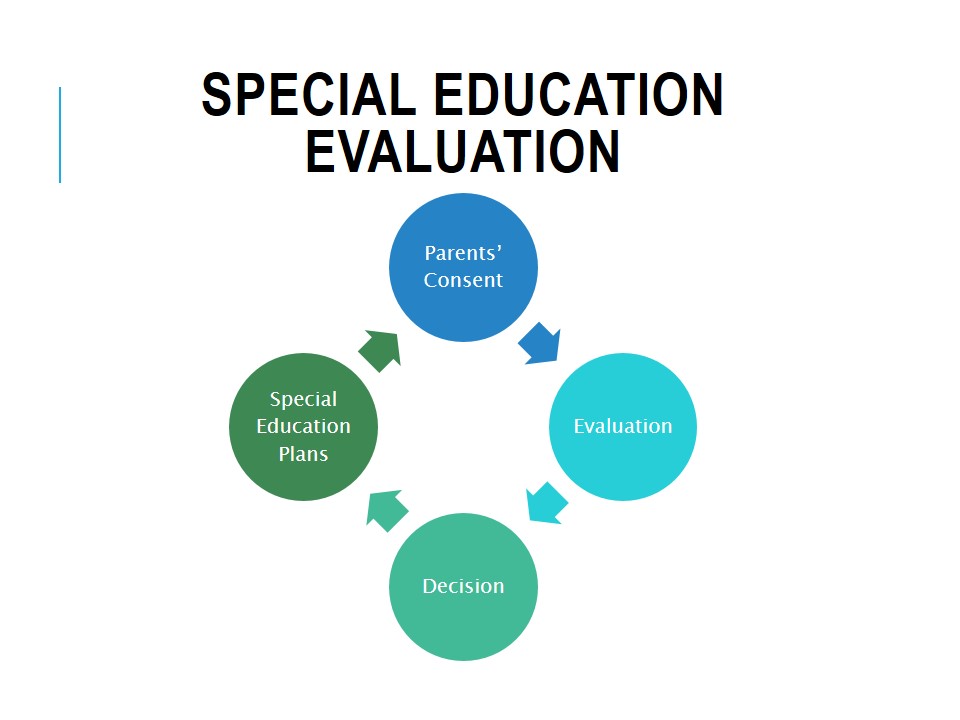
Special Education Plans: IFSP
Individualized Family Service Plan (IFSP) includes:
- Data regarding the level of the child’s development;
- Information concerning the family;
- Central outcomes;
- Intervention details;
- Environment;
- Responsible person’s details;
- Transition.
The IFSP contains information regarding the child’s current medical condition and level of development (cognitive, physical, emotional, social, and adaptive) (Lawless Frank, 2016). The IFSP also highlights the family’s resources, expectations, concerns, and priorities. Major outcomes are described in detail (criteria, timeline, evaluation, procedures) in the IFSP. The plan contains all the relevant data concerning the intervention (methods, frequency, level of parental involvement, intensity). The information regarding the environments in which the services will be provided, as well as the corresponding justification, will be included. The intervention timeline and contact details of the professional responsible for its implementation are also a part of the plan. Finally, the steps necessary for the successful transition of the child to the following stage (pre-school education) are outlined.
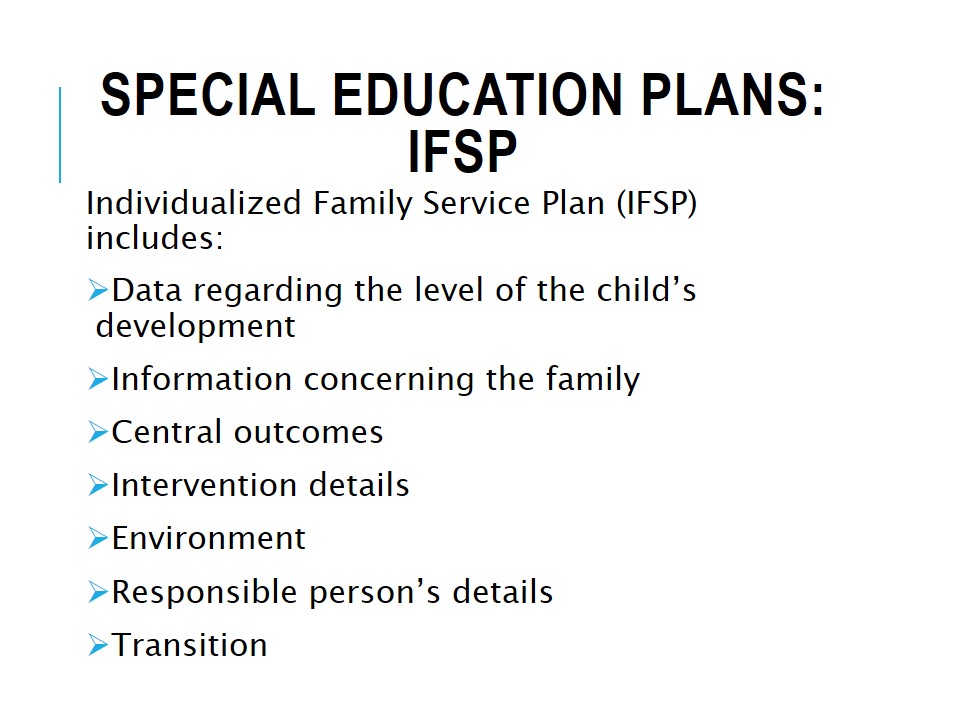
Special Education Plan: IEP
Individual Education Plans include:
- Current level of performance;
- Goals;
- Special education services;
- Other considerations.
The IEP has certain similarities with IFSP as it provides detailed information regarding the services that will be provided to the child with a disability listed in IDEA aged between 3 and 21 years old (Lawless Frank, 2016). The IEP includes the data regarding the student’s current level of performance (developmental peculiarities, medical conditions, academic performance, and similar details). The plan also contains the primary goals to be attained as well as the description of the child’s expected progress and its evaluation. A detailed description of the services that will be provided is given. These include specific tasks, activities, instructional procedures, accommodation, transportation, and any other services needed to address the child’s needs (Lawless Frank, 2016). Finally, the IEP contains information about the child’s participation in general assessments, counseling, therapy, and so on.

Special Education Plan: 504 plans
The major features of 504 plans include:
- No requirements to format;
- Parental permission is required for the child’s evaluation;
- Common elements of 504 plans;
504 plans are provided to children aged between 3 and 21 in terms of the Rehabilitation Act of 1973 (Pierson et al., 2017). Children eligible for this program can have any disability or condition that creates a barrier to receiving educational services provided in educational establishments. Parental permission is necessary before the conduction of the child’s evaluation as well as the introduction of changes to the child’s academic agenda. 504 plans do not have any specific requirements regarding format. Common elements included in the plan are the services (accommodations, support, and so on), contact details of the involved stakeholders, contact details of the person responsible for the implementation of the plan.

Special Education Plans Comparison
Available special education plans have much in common as they include the description of steps, measures, and activities that will be implemented to assist children with special needs. The IEP and IFSP differ in terms of children’s age and steps to be undertaken (Lawless Frank, 2016). 504 plans are broader than IEPs and IFSP as they cover children with all kinds of special needs beyond the 13 disabilities outlined in the IDEA.
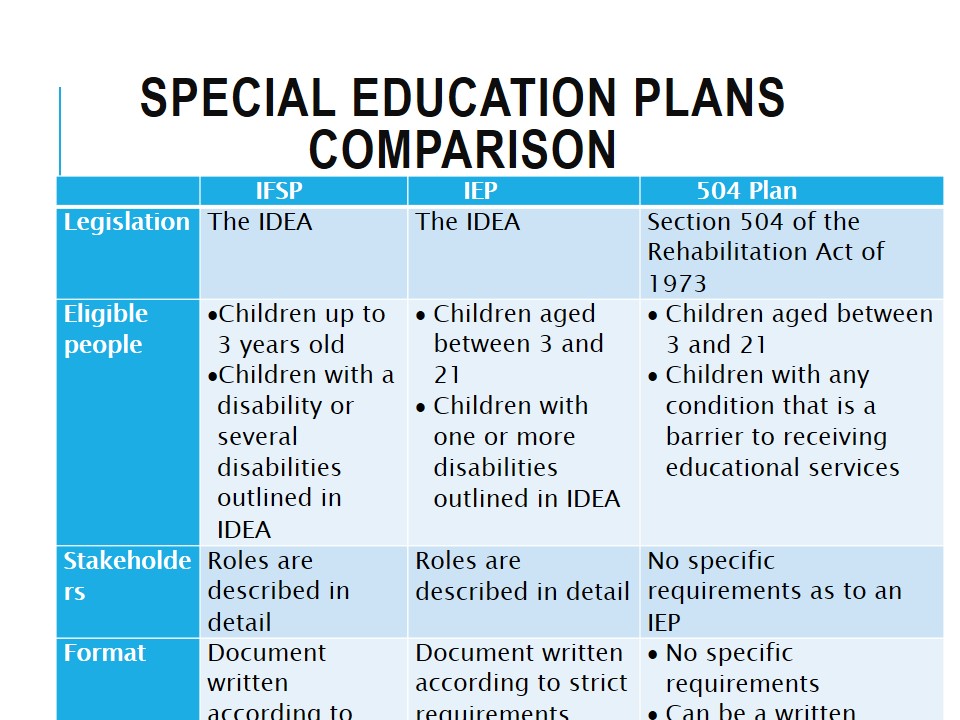
Roles of the family
- Families:
- Provide a referral;
- Address the corresponding programs and professionals;
- Give their consent;
- Provide all the necessary information;
- Participate in IEP meetings;
- Follow the given recommendations;
- Are active, supportive, and positive.
Families play an important role in their child’s special education. They often initiate the process of evaluation and their child’s participation in the program as they are often the first ones to acknowledge that their child needs assistance (Lipkin & Okamoto, 2015). Families provide a referral and give their consent for evaluation. They take an active part in the development of the IEP (IFSP or 504) plan for their child. Of course, they should be encouraged to follow the given recommendations, as well as motivated to remain active, supportive, and positive.
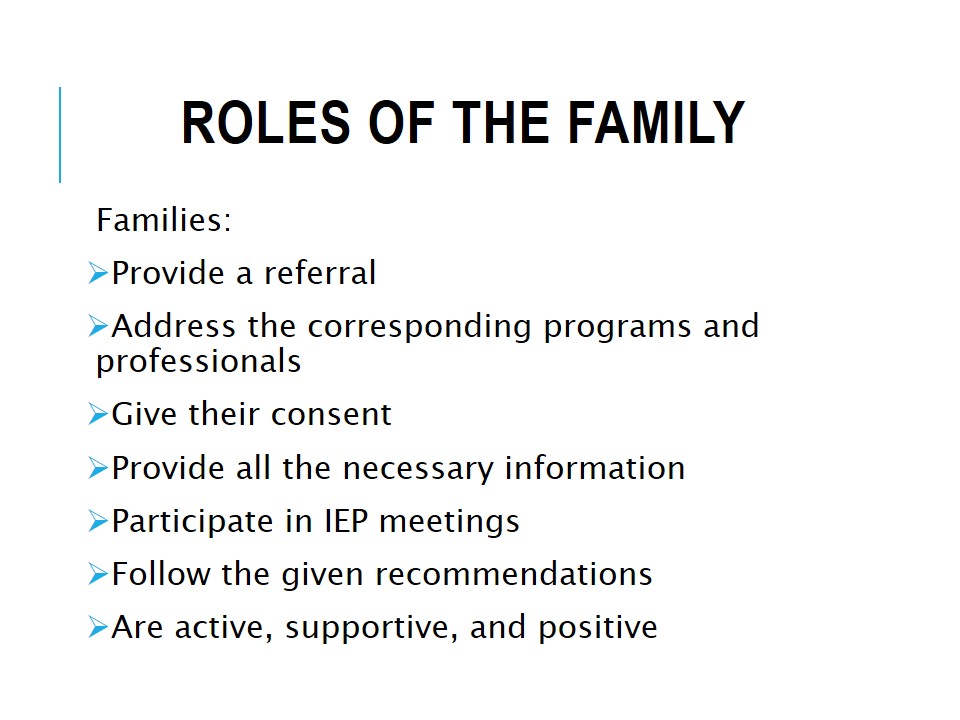
Roles of School and Faculty
- Schools:
- Provide referrals;
- Evaluate children;
- Provide recommendations as to child’s needs;
- Play a central role in the development of IEPs;
- Implement IEPs;
- Assess the progress;
- Re-evaluate.
School faculty, administration, counselors, and other professionals play an important role in the development and implementation of special education plans (Lawless Frank, 2016). Schools can provide referrals and respond to families’ referrals. They obtain parental consent, evaluate children’s conditions, and give recommendations as to the most appropriate and beneficial educational services for children. Since educators tend to be fully informed about the programs, they are central to the development of IEP and their implementation. Schools are also responsible for the assessment of the effectiveness of special education programs and children’s re-evaluation.
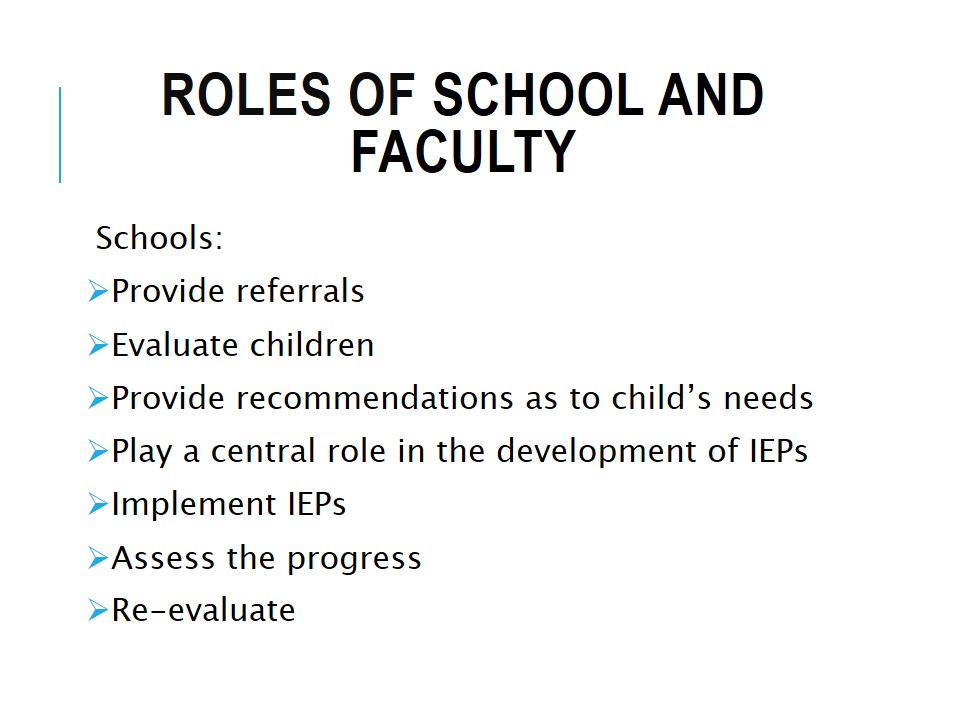
Methods of Communication
- Communication channels;
- Written communication;
- Oral communication.
The primary goal of special education programs is to help children to succeed in their academic life. Therefore, it is essential to use all possible opportunities to ensure the effectiveness of educational programs (Lawless Frank, 2016). Educators may employ various communication channels, including face-to-face communication, email, social networks (Facebook, Twitter), instant messaging, telephone, and even post. When developing IEPs, assigning tasks for stakeholders, and providing important information, written communication is preferable as it ensures certain clarity. However, verbal communication is also vital, as stakeholders should meet and discuss various issues regarding children’s communication.

Conclusion
- Special education focus: children’s progress.
- Stakeholders involved: schools, other specialists, families, and children.
- Key to success: collaboration.
The major goal of special education is to help all students benefit from the educational services provided to them. The stakeholders involved in the process are children, educators, school administration, mental health professionals, counselors, other professionals, and parents. Therefore, it is clear that collaboration is the key to the success of special education programs such as IEP, IFSP, and 504 plans among others.

References
Lawless Frank, C. (2016). Referral and identification for special education: RTI Tier Three. In S. B. Richards et al. (Eds.), Collaboration among professionals, students, families, and communities: Effective teaming for student learning (pp. 53-77). New York, NY: Routledge.
Lipkin, P. H.., & Okamoto, J. (2015). The Individuals with Disabilities Education Act (IDEA) for children with special educational needs. PEDIATRICS, 136(6), e1650-e1662. Web.
Olson, K. B. (2017). After the Visit: An Overview of Government and Community Programs Supporting Children with Medical Complexity. Children, 4(5). Web.
Pierson, E. E., Callan, G. L., & Pierson, S. K. (2017). An overview of special education law, 504, FERPA, and issues relevant for pediatric neuropsychologists. Journal of Pediatric Neuropsychology, 4(1-2), 27-36. Web.